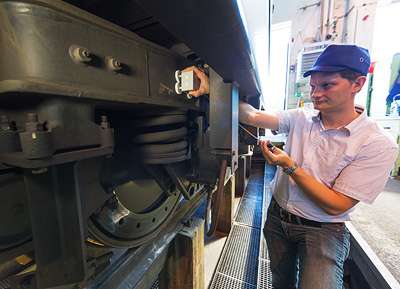Wireless sensors for commissioning of rail vehicles

A network of wireless sensors should soon be simplifying the process of commissioning rail vehicles. Experts from Siemens have developed a wireless sensor system that measures the mechanical loads to which a rail vehicle is subjected during operation. As reported in the latest edition of the Siemens research magazine Pictures of the Future, the sensors measure, for example, the degree of vibration at various points. For this purpose, they require very little energy and, thanks to wireless technology, can be used without the need to lay cables.
Once the mechanical loads applying to various components are more precisely known, it will be possible to make rail vehicles more energy-efficient. Only when the static and dynamic safety of the locomotive is guaranteed can engineers begin to think about using less material. At the same time, modern locomotives consist of an ever-greater number of components from different suppliers. To ensure that all of these different parts interact smoothly, the mechanical loads to which each is subjected must be precisely defined in the design requirements. Exact knowledge of these mechanical loads is also necessary in order to make reliable predictions regarding service life and maintenance intervals.
At present, the sensors used to measure the tensile and impact loads to which a rail vehicle is subjected while moving are all still wired via cable to a data-logging unit. Hardwired sensors are also used in wind turbines, cars, and aircraft. For rail vehicles, in particular, this involves several drawbacks. To begin with, hardwiring all the sensors within a locomotive is a complicated job. Moreover, this exposes them to lots of electromagnetic interference. On the other hand, cables laid along the outer body of the locomotive are exposed to the full impact of the elements; while on the underside of the locomotive, they are vulnerable to damage from stones in the track bed.
Experts in sensor and wireless technology from the Siemens global research unit Corporate Technology developed the wireless sensor system as part of the government-sponsored research project Akusens. As many as 20 sensor nodes can be operated simultaneously and data from each of them logged synchronously. Fitted to each sensor node is a triaxial acceleration sensor that continuously takes measurements. In this way, it is possible to build up a profile of the vibrations and loads to which the rail vehicle is subjected and thereby describe the long-term stresses on individual components. Similarly, the vibration data in the profile also shows how torsion affects the superstructure and running gear. To the human eye, however, such movements remain invisible, since the components affected move only a few millimeters.
Over a period of nine months, the system underwent trials on the route between Rotterdam and Muttenz, a municipality in Switzerland. The sensors were fitted to a freight locomotive operating in normal service. The wireless sensors continued to perform precisely and reliably at temperatures between -20 and +85 degrees Celsius. In the future, the sensors will also be tested in other areas of application.
Provided by Siemens


















